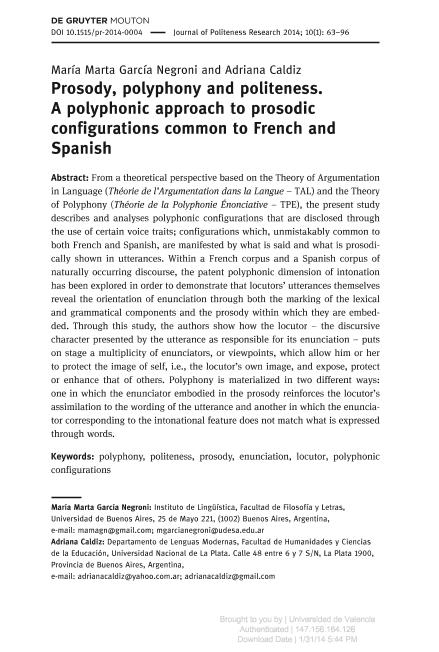Mostrar el registro sencillo del ítem
dc.contributor.author
Garcia Negroni, Maria Marta

dc.contributor.author
Caldiz, Adriana Mabel

dc.date.available
2018-01-22T20:35:48Z
dc.date.issued
2014-01
dc.identifier.citation
Garcia Negroni, Maria Marta; Caldiz, Adriana Mabel; Prosody, polyphony and politeness: A polyphonic approach to prosodic configurations common to French and Spanish; De Gruyter; Journal of Politeness Research; 10; 1; 1-2014; 63-96
dc.identifier.issn
1612-5681
dc.identifier.uri
http://hdl.handle.net/11336/34163
dc.description.abstract
From a theoretical perspective based on the Theory of Argumentation in Language (Théorie de l’Argumentation dans la Langue – TAL) and the Theory of Polyphony (Théorie de la Polyphonie Énonciative – TPE), the present study describes and analyses polyphonic configurations that are disclosed through the use of certain voice traits; configurations which, unmistakably common to both French and Spanish, are manifested by what is said and what is prosodically shown in utterances. Within a French corpus and a Spanish corpus of naturally occurring discourse, the patent polyphonic dimension of intonation has been explored in order to demonstrate that locutors’ utterances themselves reveal the orientation of enunciation through both the marking of the lexical and grammatical components and the prosody within which they are embedded. Through this study, the authors show how the locutor – the discursive character presented by the utterance as responsible for its enunciation – puts on stage a multiplicity of enunciators, or viewpoints, which allow him or her to protect the image of self, i.e., the locutor’s own image, and expose, protect or enhance that of others. Polyphony is materialized in two different ways: one in which the enunciator embodied in the prosody reinforces the locutor’s assimilation to the wording of the utterance and another in which the enunciator corresponding to the intonational feature does not match what is expressed through words.
dc.format
application/pdf
dc.language.iso
eng
dc.publisher
De Gruyter

dc.rights
info:eu-repo/semantics/openAccess
dc.rights.uri
https://creativecommons.org/licenses/by-nc-sa/2.5/ar/
dc.subject
Prosodia
dc.subject
Polifonía
dc.subject
Cortesía
dc.subject
Francés-Español
dc.subject
Enunciación
dc.subject
Locutor
dc.subject.classification
Estudios Generales del Lenguaje

dc.subject.classification
Lengua y Literatura

dc.subject.classification
HUMANIDADES

dc.title
Prosody, polyphony and politeness: A polyphonic approach to prosodic configurations common to French and Spanish
dc.type
info:eu-repo/semantics/article
dc.type
info:ar-repo/semantics/artículo
dc.type
info:eu-repo/semantics/publishedVersion
dc.date.updated
2018-01-22T14:47:02Z
dc.identifier.eissn
1613-4877
dc.journal.volume
10
dc.journal.number
1
dc.journal.pagination
63-96
dc.journal.pais
Reino Unido

dc.journal.ciudad
Sheffield
dc.description.fil
Fil: Garcia Negroni, Maria Marta. Consejo Nacional de Investigaciones Científicas y Técnicas; Argentina. Universidad de Buenos Aires. Facultad de Filosofía y Letras. Instituto de Lingüística; Argentina
dc.description.fil
Fil: Caldiz, Adriana Mabel. Universidad Nacional de La Plata. Facultad de Humanidades y Ciencias de la Educación; Argentina. Universidad Nacional de La Plata. Facultad de Humanidades y Ciencias de la Educación. Departamento de Lenguas Modernas; Argentina
dc.journal.title
Journal of Politeness Research
dc.relation.alternativeid
info:eu-repo/semantics/altIdentifier/doi/https://www.degruyter.com/view/j/jplr.2014.10.issue-1/issue-files/jplr.2014.10.issue-1.xml
Archivos asociados
